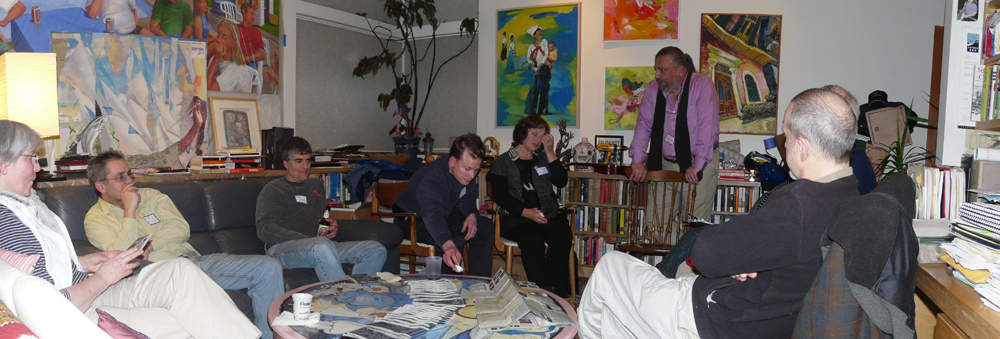|
Meeting Minutes from InspireSeattle Social on February 25, 2012
Clean-up of the Duwamish River
Our Guest Speaker:
James Rasmussen has worked for 30 years to restore the Duwamish River to its
former state. He is the current coordinator and a founding member of the Duwamish
River Cleanup Coalition (DRCC), a Duwamish tribal council member, a founding
member of the Green Duwamish Watershed Alliance, and a founding member of the
WRIA #9 habitat plan. (We also learned that he is a lifelong trumpet player and
the current
manager of the group Jazz Police.)
If in 30-40 years
fishermen can again catch and eat the fish from the Duwamish River, James
Rasmussen will consider this a success. He sees this as a realistic goal in a talk
that conveyed his knowledge, warmth, inclusiveness and perhaps most of all,
his optimism.
The Duwamish River is Seattle's only river, winding
between West Seattle and I-5 before emptying into Elliott Bay. James
shared with us his comprehensive knowledge of the river, the Duwamish people,
and the current clean-up efforts to save the river.
James started the evening with a history of
the Duwamish tribe. The Duwamish people settled as far east as Lake Sammamish, as far south as
Burien, as far west as Vashon Island, and
as far north as Shoreline with their largest settlement near the Black River in Renton. Over 150
longhouses made up a community within the Duwamish Basin as recently as the 19th century. (All were burned in the early 1900's.) Now the Duwamish make up a
'landless tribe', an "urban tribe". One can learn more about Duwamish at the Duwamish Longhouse and
Cultural Center on West Marginal Way SW in West Seattle. It is home to social,
educational, and recreational classes for tribal and non- tribal people.
Key issues concerning the clean-up of the Lower Duwamish
include:
- Why is the river polluted?
- What contaminates the river? (A list including over 45 different carcinogens)
- Who is responsible?
- How long will this task take?
The U.S. Environmental Protection Agency (EPA) listed the
Lower Duwamish River--a five-mile stretch through South Seattle--as a federal
Superfund site in 2001. The Superfund list is a roster of the most contaminated
sites in the country. Federal funding for the clean-up of Superfund sites ended
under the Clinton administration, however the Superfund remains an important legal designation
that brings the EPA's expertise and legal authority to enforce the clean-up.
Four entities are paying the cost of clean-up in the Duwamish Basin: the City of Seattle,
King County, the Port of Seattle, and Boeing. Other industries will be identified as
potentially responsible parties.
The Duwamish sediments contain a toxic stew of industrial
carcinogens such as polychlorinated biphenyls (PCBs), oil and other hydrocarbons,
mercury, lead, arsenic and other heavy metals, dioxin, pesticides, and raw
sewage. PCBs are now found in nearly all salmon in the River.
Many of these pollutants pose serious
health risks by building up in the tissues of fish and shellfish, and passing
through the food chain to eagles, seals, orcas, and people. People who regularly
eat fish and crab from the River are at the greatest risk. However, toxins are sufficiently concentrated in some of the Duwamish river-bottom mud
that people
should also avoid daily contact.
There are two aspects to the clean-up:
1)
Remove/Contain the Existing Contaminants -- Boeing owns the site known as
Slip 4 and it has
now been completely dredged. This process involved new technologies
including one that seals
the mud being dredged to prevent resuspension of toxic mud into the flowing
water. A second site owned by Boeing, known as Plant 2, produced bombers during World War II. Unfortunately the
toxic byproducts of this effort were freely dropped below the plant during
wartime.
Boeing has already committed to completely dredging out sediment 30 feet deep.
2) Control Sources of Pollution
Flowing into the Duwamish -- This is the approach advocated by DRCC advocates. If
"nothing dirty comes into the river, then the river will take care of itself."
Currently storm drains on Beacon Hill, Capitol Hill and South Seattle flow
directly into the Duwamish River. Clean-up of all upstream sources will require
additional cost from the responsible parties including: green
infrastructure, natural drainage, the monitoring of storm drains and of
overburdened combined sewage overflows.
The Duwamish River neighborhoods (e.g.,
Georgetown and South Park) include many low income, immigrant,
and minority families. The clean-up of the Duwamish is not only an issue of
environmental justice but also one of economic justice. The DRCC
collaborates with other community groups to
- Produce new, living-wage jobs through the
impending clean-up work
- Raise the standards for cleaner housing standards
- Serve as stewards for wildlife habitat restoration
- Enhance healthy recreation sites
- Create thriving communities/neighborhoods
What can you do?:
- Visit the Duwamish River Cleanup Coalition website to download a map of the Duwamish watershed,
to sign up for action alerts, or to attend their events.
- Contact members of the city and county government as well as the Port of
Seattle to urge their continued support for the clean-up of the Duwamish.
|
|
| |
Previous meeting minutes
- June 3, 2017, Immigration Workshop
- February 19, 2017, Action Against Trump
- December 4, 2016, Transforming Anger
- July 9, 2016, Growth in West Seattle
- May 7, 2016, Trans-Pacific Partnership
- March 5, 2016, Hidden Half of Nature
- November 15, 2015, Nick Licata: ALEC
- October 3, 2015, City Council Forum
- May 30, 2015, Income Inequality
- April 25, 2015, Ending the War on Drugs
- March 14, 2015, Consequences of Energy
- February 7, 2015, Fighting Hunger
- November 15, 2014, Restoring Democracy
- October 4, 2014, The Political Mind
- May 31, 2014, Obamacare
- May 3, 2014, Surveillance Technology
- March 8, 2014, Sexual Abuse in the Military
- January 25, 2014, No New Jim Crow
- November 16, 2013, WAmend: SuperPacs
- October 19, 2013, Earthquake Risk
- September 7, 2013, Wiring the Brain
- June 8, 2013, Who are the Moochers?
- April 27, 2013, Port of Seattle
- March 23, 2013, Electing by District
- February 23, 2013, Beyond Coal
- January 12, 2013, Saving Our Forests
- October 20, 2012, Climate Change
- September 15, 2012, Initiative Process
- June 16, 2012, J Street
- May 12, 2012, Transportation in Seattle
- March 31, 2012, Death Penalty
- February 25, 2012, Duwamish River
- January 21, 2012, Bob Ferguson
- November 19, 2011, Immigration Policy
- October 15, 2011, Inequality
- June 18, 2011, Social Justice Issues
- May 21, 2011, Washington Investment Trust
- April 23, 2011, Panel: Community Needs
- February 26, 2011, Sustainability
- January 22, 2011, Social Security
- November 6, 2010, Health Care Reform
- October 2, 2010, Charter Schools
- June 26, 2010, Sustainable Biofuels
- May 22, 2010, Education in Afghanistan
- March 20, 2010, Debt Relief
- January 23, 2010, Recycling
- November 7, 2009, Genetically Engineered Foods
- October 10, 2009, Homelessnesss
- September 19, 2009, Population
- June 13, 2009, Racism
- May 16, 2009, Nuclear Energy
- April 11, 2009, Affluenza
- March 7, 2009, Education
- January 10, 2009, Iraqi Refugees
- November 8, 2008, Palestine
- October 11, 2008, Corporate Responsibility
- September 13, 2008, Sally Clark
- June 21, 2008, U.N. Millenium Goals Project
- May 16, 2008, Evangelicalism
- March 29, 2008, Media
- February 23, 2008, Niger Delta
- January 19, 2008, Environmental Issues in Washington State
- Nov. 17, 2007, Affordable Housing
- Oct. 13, 2007, Health vs. Healthcare
- Sept. 8, 2007, Nick Licata
- June 23, 2007, Local Transportation
- May 5, 2007, Global Warming
- Mar. 31, 2007, Publicly Financing Campaigns & Impeachment
- Feb. 09, 2007, Family Planning and Population
- Jan. 6, 2007, Peak Oil
- Oct. 20, 2006, Upcoming Election, David Goldstein
- Sept. 17, 2006, Initiative Process
- July 22, 2006, Women in Politics
- June 10, 2006, Local Transportation
- April 22, 2006, Language in Politics
- Feb. 25, 2006, War in Iraq
- Jan. 14, 2006, Eric Oemig
Previous IAN Events
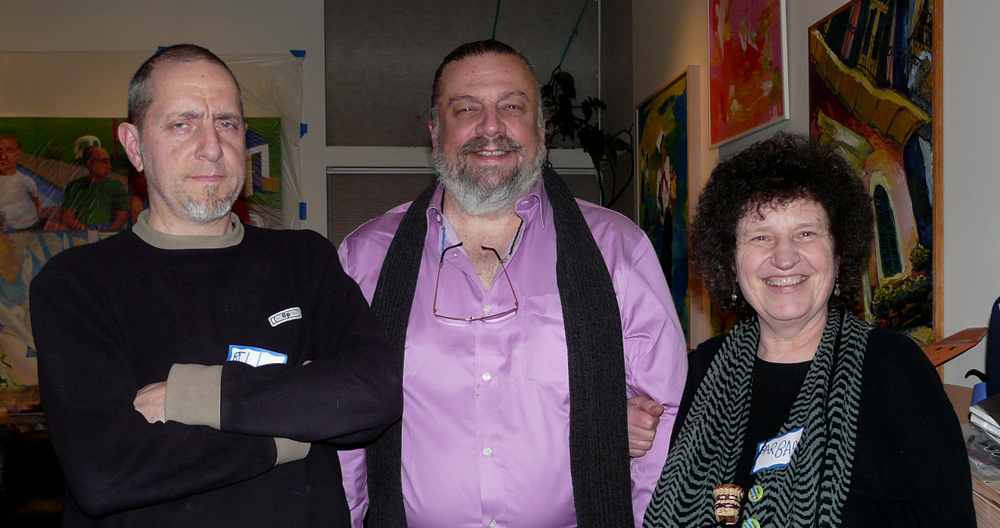
Thank you to
Bill Bradford (left) for hosting this event
James Rasmussen (center), our speaker
Barbara Sardarov (right), for organizing this event and emceeing
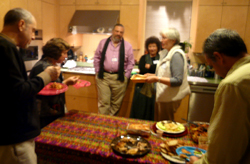
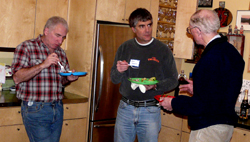
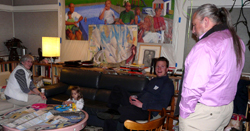
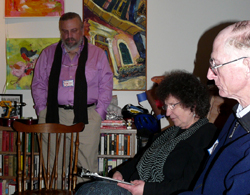
|
|


 PAST SOCIALS
PAST SOCIALS

 PAST SOCIALS
PAST SOCIALS